CAN SIT-UPS CAUSE CONSTIPATION? - 6 REASONS
- Medically reviewed by: Horia Marculescu, MD
- Photo credits: Licenses / Author
- Last updated: Jul 19, 2024
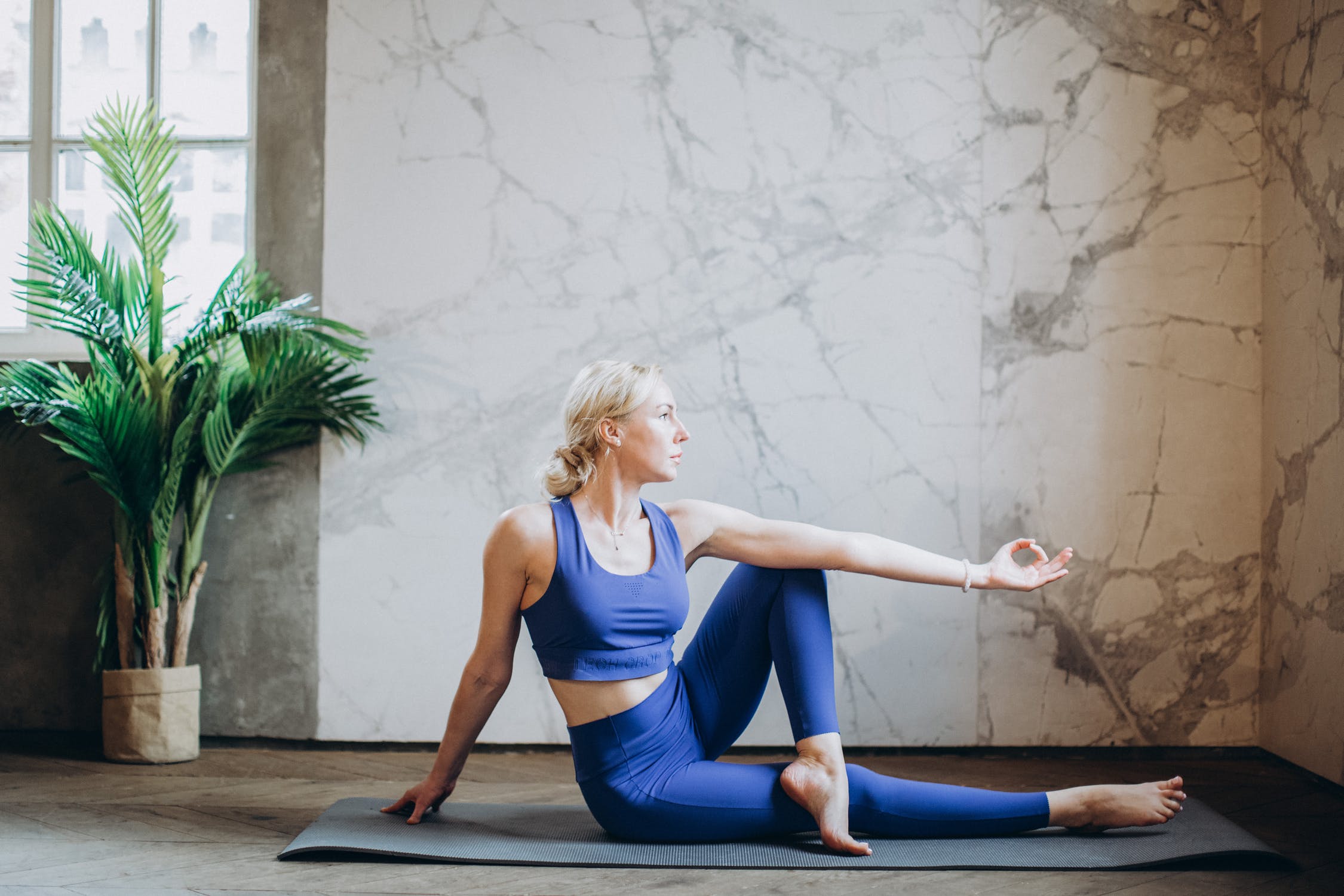
Can sit-ups cause constipation? Yes, sit-ups can cause this symptom. But there are a few reasons that influence this symptom like:
- Stress
- Fatigue
- Dehydration
- Muscle soreness
- Blocked dry, hard stool
- Twisted bowel obstruction.
Sit-ups are a type of exercise that involves rotating the lower body from a straight position to ninety degrees. The rotation creates an L-shaped body on the ground.
This thing puts the abdominal muscles and the pelvic floor muscles to work. Also, sit-ups are an excellent workout for body sculpting and stress relief.
Follow the guide and learn how to prevent sit-ups from causing constipation in the long term.
STRESS AND SIT-UPS CAN LEAD TO EPISODIC CONSTIPATION
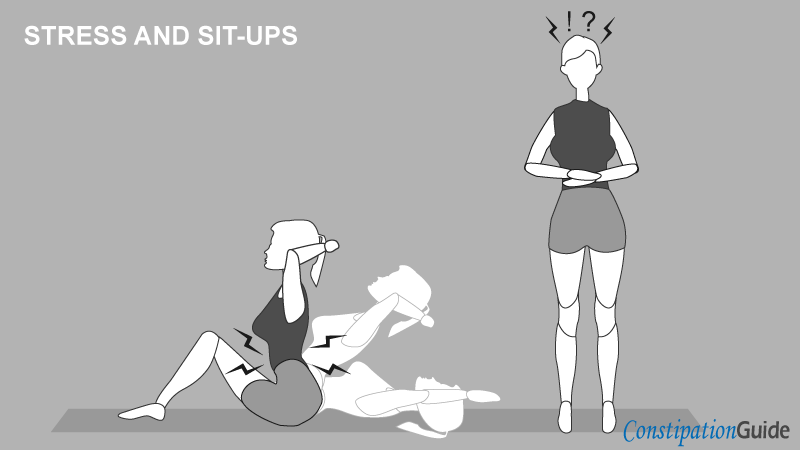
Can sit-ups cause constipation when you are stressed? Although this exercise creates adrenaline to fight stress, sometimes it is not enough for the body to relieve stress.
Stress is one of the most common causes of episodic constipation. The reason is that it makes the body send all the resources to the vital organs.
The most affected organs are:
- Heart
- Brain
- Muscles.
This thing means that digestion and bowel movement are not priorities in those stressful intervals of time. The blood flow and oxygen will go towards the vital organs during exercise.
Although a workout, in general, is an excellent way for stress relief, sometimes, the effort of doing sit-ups can slow down transit. Working the abdomen with insufficient blood flow, water, and liquids can slow the intestinal transit.
The adrenaline that comes as a result of a workout will temporarily alleviate the negative symptoms. But, after 3-4 hours, you will feel symptoms like discomfort, pain, irritation, and a sensitive belly.
Here are a few things to do if you are stressed:
- Rest and do light stretching.
- Eliminate the stress causes.
- Start with a few sit-ups.
It is essential to eliminate the causes of stress because the body will function better. Digestion, intestinal transit, and bowel movement are complex processes.
If you can’t get rid of stress immediately, focus on those things that cause it. And start working out after you have finished with it.
What do the health experts say?
According to a guide about stress and mental health published by The U.K. National Health System:
Try to find the causes of stress and manage them. Here are the most common ones: too much pressure at work, health issues, injuries, retirement, and unemployment.
According to a guide called Healthy Eating and Physical Activity for Life, published by the U.S. NIDDK, managing stress by getting enough sleep, regular physical activity, and maintaining your ideal weight are great ways to prevent health problems.
2.FATIGUE AND SIT-UPS DO NOT IMPROVE BOWEL MOVEMENT

Can sit-ups cause constipation when the body is too tired? Of course, they can. Fatigue, in general, slows down the internal functioning of the body.
Too much workout and intense stretching cannot improve intestinal transit. A tired body can’t handle digestion properly. This situation is similar to having long intervals of stress.
Although sit-ups work the abdomen and the pelvic floor muscles, too much physical effort can affect the muscle tissues.
This thing means that:
- It will take longer for the body to recover.
- Those tissues have to regenerate using proteins.
Your body requires hydration after workouts, especially for fast constipation relief with exercises. The body needs an even larger quantity of vitamins and nutrients. If you feel fatigued and practice sit-ups, then stop and rest.
Here are a few things to do whenever you feel irritation, abdominal discomfort, or pain after sit-ups:
- Take a break.
- Warm up the body.
- Drink water and fresh fruit juice.
If the irritation and discomfort persist, it is time to stop the physical activity and rest. Rest, eat proteins, and hydrate your body as fast as possible.
What do the health experts say?
According to a study about fatigue, IBD, and psychological factors published by The American Gastroenterological Association, the feeling of being fatigued can increase over time in patients with IBD. It is necessary to improve the psychological aspects to avoid fatigue.
According to another study about behavioral therapy and fatigue in young adults with Crohn’s disease, published by the same health authority, the most common symptoms of people with Crohn’s disease are fatigue and sleep deprivation.
3. DEHYDRATION AND ABDOMINAL WORKOUT CAUSE CONSTIPATION
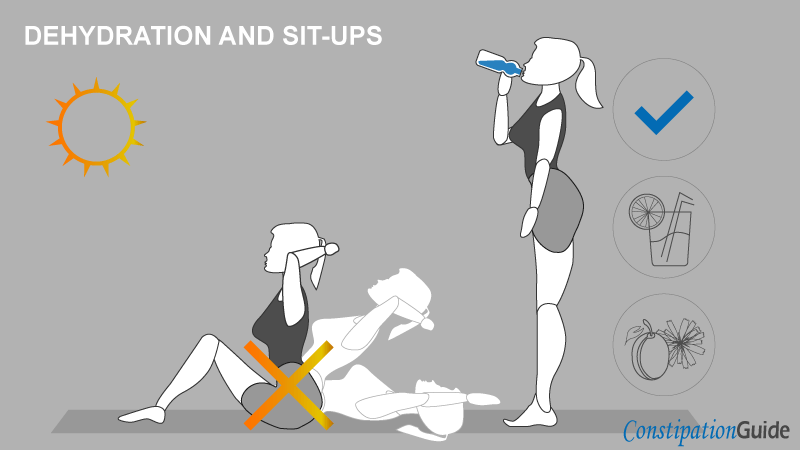
Can sit-ups cause constipation when the body does not receive enough water?
Dehydration causes constipation because water is not present in the stool after it reaches the large intestine. This process happens in general, for most people most of the time.
Hydrating the body is a complex process that requires:
- Minerals;
- Vitamins;
The process requires these elements to prepare the chemical reactions inside the body. Hydrating the body means having the right quantities of chemicals so that the muscles work optimally.
This process also applies to digestion and bowel movement because they require the same chemical elements. If dehydration happens often, the stool inside the large intestine will become hard and dry.
You will feel irritation if you rotate your body with lots of dry and hard stool inside. And you will continue to have constipation in the future.
Here are a few things to do to prevent dehydration:
- Drink non-carbonated mineral water.
- Wait thirty minutes after eating fruit.
- Eat fruits on an empty stomach.
- Drink water during sit-ups.
Eating fruits on an empty stomach is the best way to assimilate vitamins and nutrients. Fermentation will create gas and bloating if you eat fruits after a meal.
You can relieve gas with some exercises. But it is better to eat food the right way. Try not to combine fruits with any food, especially with meat.
Eating vegetables with meat is another way to assimilate vitamins and nutrients. Eat liquid food like fruit compote (stewed fruit), soup, and shakes to have bowel movements regularly.
What do the health experts say?
According to a technical review on constipation published by The American Gastroenterological Association, evidence shows that increasing physical activity is beneficial for constipation. Evidence shows that fluid intake can treat constipation only if there is evidence of dehydration.
According to a study called The Pathophysiology of Chronic Constipation, published by the U.S. National Library of Medicine, the colon is the organ that absorbs the fluid and moves the fecal matter to the rectum for evacuation. Removing the water from the fecal matter is directly influenced by time and can increase when dehydration is present.
4. MUSCLE SORENESS AFFECTS RECOVERY AFTER SIT-UPS

Muscle soreness is the result of exercising too hard for too long. Practicing sit-ups often without being in shape is usually a bad idea. Sit-ups can cause constipation after too much workouts. You can shorten the time by doing some exercises for fast results, but the effort will remain the same.
Muscle soreness is similar to stress because the affected area does not have:
- blood flow;
- oxygen;
- water.
Muscle soreness is an indirect cause of constipation because it does not affect the stool directly. It influences the re-direction of the resources inside the body.
This process means that the blood flow, proteins, nutrients, and vitamins will focus towards regenerating the muscle tissues.
Working the muscles requires the tissues to contract. Exercising for too long will irritate the intestinal tissues.
You can regenerate the tissues by eating proteins and vitamins. Proteins regenerate the tissues after a workout. Rest will help digestion to process and assimilate the food properly.
According to a study called Stretching for Prevention of Exercise-Related Injury, published by The American Academy of Family Physicians, the study (twelve-week measurement) found that stretching (before and after exercise) alleviated muscle soreness by four units on a 100-unit scale.
5. BLOCKED, DRY, AND HARD FECAL MATTER IS NOT A GOOD SIGN BEFORE SIT-UPS
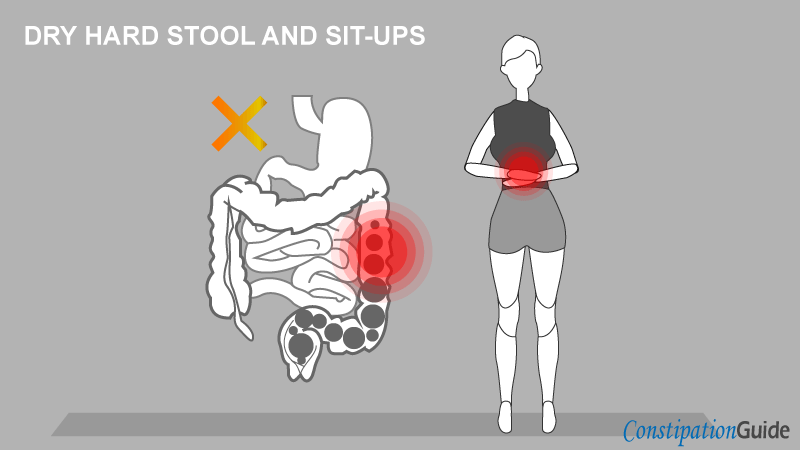
Blocked and dry fecal matter can cause constipation in the short term. The symptoms can become worse after sit-ups.
The presence of stool in the large intestine that sticks like glue to the intestinal walls is not helpful for sit-ups. The reason is that dry stool cannot move towards the rectum.
The more you exercise the lower abdomen (and the pelvic floor muscles), the more likely the stool will disintegrate.
Unfortunately, sometimes, the dry stool will not move. It can damage the intestinal lining and tissues. When this happens, you will feel irritation and discomfort.
What does the medical research say?
According to a guide about digestive disease and constipation in children, published by The U.S. National Institute of Diabetes and Digestive and Kidney Diseases, dry, hard, lumpy, and hard-to-pass stools are common symptoms of constipation in children.
According to a guide about constipation symptoms and causes published by the same health authority, other factors that can cause hard and dry stools are anorectal blockage, tumors, and intestinal obstructions.
6. TWISTED BOWEL OBSTRUCTION AND SIT-UPS SLOW DOWN DIGESTION

Can sit-ups cause constipation in someone who suffers from twisted bowel obstruction? It is essential to know what twisted bowel obstruction is.
Twisted bowel obstruction (Volvulus) is the incorrect positioning of the intestinal segments inside the body. Segments of the small intestine are twisting around other segments.
Loops of the intestine can create a blockage that can be:
- Total;
- Partial;
- Mechanical;
- Non-mechanical.
Regardless of the type present inside, the blockage slows food, liquids, and gas moving toward the large intestine.
Feeling gas moving inside the intestines and the need to evacuate it is not comfortable. Slow and gentle body movements make the body adapt to physical effort.
Also, the small intestine can twist around itself. It can twist around the mesentery that supports it. This thing creates an obstruction even though the intestine functions at its limiting capacity. The intestine will still get fluid and blood.
In rare cases, the blood flow and fluid filling will stop, thus affecting those parts of the intestine. This thing leads to blood-starved tissues and non-functioning intestinal walls.
According to a guideline about endoscopy and colonic volvulus published by The American Society of Gastrointestinal Endoscopy, the sigmoid colon is the most common place where the Colonic volvulus occurs. Bowel twisting along its mesenteric axis will result in colonic pseudo-obstruction and colonic volvulus.
7. WHAT ARE SIT UPS, AND WHAT BODY PARTS DO THEY AFFECT?
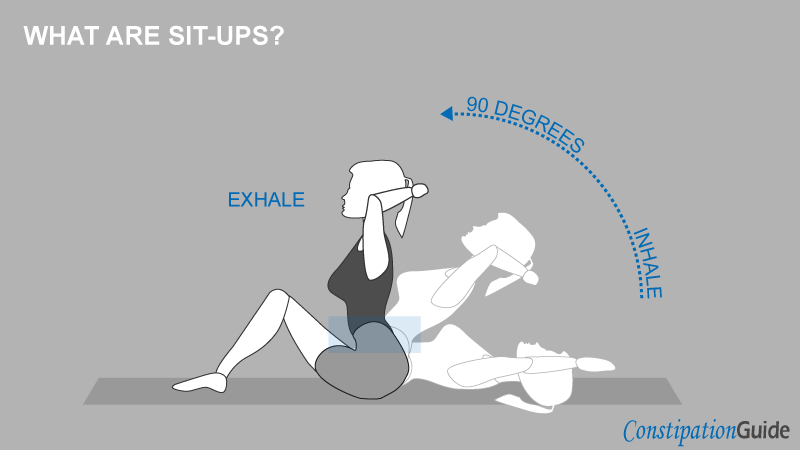
Can sit-ups cause constipation? Before exploring this subject, we must first understand what sit-ups are and what body parts they affect.
Sit-ups focus mainly on the abdomen and the pelvic floor muscles. They also put work on the shoulders, arms, and things.
The basic movements of this exercise are:
- Sit on a fitness mat with your back straight and legs bent.
- Lower your upper body to the floor, keeping your core engaged.
- Return to the starting position.
The basic movement makes the abdomen contract, expand, and work by rotating the upper body. Also, place the palms and arms behind your head.
Sit-ups are excellent exercises for abdomen workouts. Rotating the upper body from the floor up to ninety degrees, back and forth, will put the entire abdomen to work.
Sometimes, they work the pelvic floor muscles because the body will imitate a squatting posture. As a result, the anorectal angle will increase, and the pelvic floor muscles will relax.
This thing causes the bottom to prepare for stool evacuation, and defecation will become natural. In the long term, sit-ups are very helpful to get rid of constipation and improve bowel movement.
8. WHAT IS THE DIFFERENCE BETWEEN SIT-UPS AND CRUNCHES?
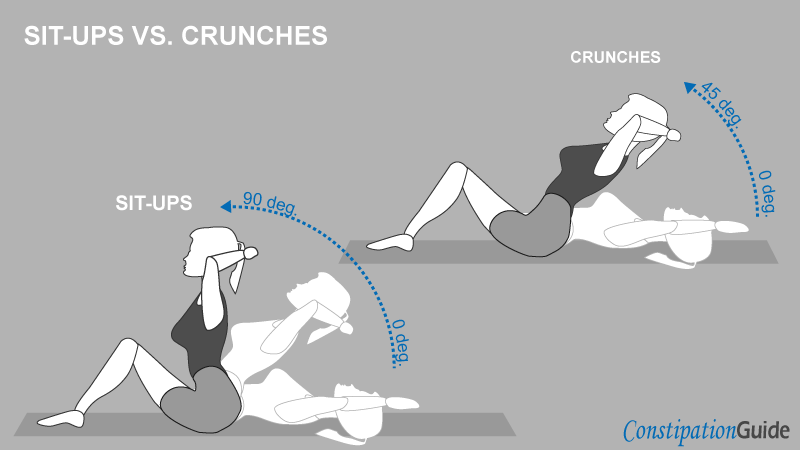
The difference between sit-ups and crunches is that sit-ups make the upper body rotate ninety degrees back and forth. On the other hand, crunches rotate the upper body for about forty-five degrees from the floor.
This thing means that crunches focus only on the abdomen (lower and upper abdomen). In this case, there won’t be any hard workouts that involve the pelvic floor muscles, thighs, or arms.
Crunches are an excellent training exercise for a six-pack in the long term. They are easy to do, and they require little effort. But this thing also requires you to be in great physical shape.
9. SUMMARY
Can sit-ups cause constipation? Yes, sit-ups can cause this symptom, but there are a few reasons. The most common ones are stress, fatigue, dehydration, and muscle soreness.
Keeping the body hydrated and not exercising too much can positively influence constipation in the long term.
In rare cases, Volvulus (twisted bowel obstruction) is another cause of constipation. People who suffer from Volvulus should visit a doctor.
Doing sit-ups is an excellent way to work the abdomen and the pelvic floor muscles. Visit a doctor if you feel irritation, abdominal discomfort, or pain.
Doing sit-ups at first is demanding. Start slow, and always remember to hydrate. Drink plenty of water and eat fruits on an empty stomach.
If you suffer from constipation after every workout, ask your healthcare professional to take blood, urine, and stool tests.
Last medically reviewed on Jul 19, 2024
